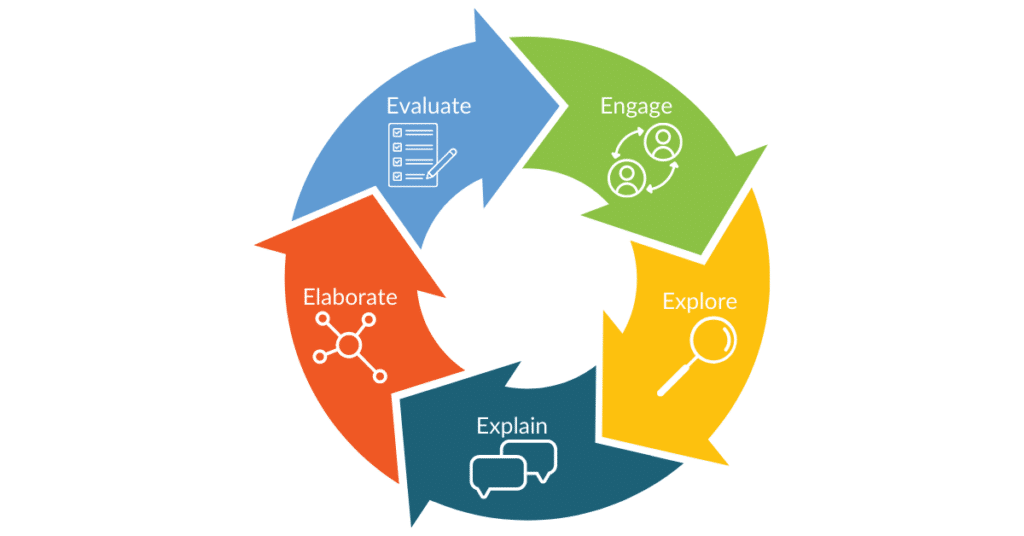
Blended Learning and the 5Es Instructional Model – Dr. Catlin Tucker
Too often in education, students are given answers to questions they did not ask and solutions to problems they have never encountered. This can lead to learning experiences that feel irrelevant to and disconnected from their lives beyond the classroom. To combat this reality, I encourage teachers of all grade levels and subject areas to check out the 5Es instructional model to promote and support student-driven inquiry, discovery, and problem-solving.
If you are thinking, “Isn’t the 5Es instructional model a science thing?” You are correct. Roger Bybee and his team originally designed the 5Es for the sciences, but it is a flexible model that can be used across grade levels and subject areas. That flexibility is what I find so exciting about this model.

Even though the 5Es instructional model is not listed in the taxonomy of blended learning models, it can fall under the umbrella of blended learning if teachers design the experience to strategically combine active, engaged learning online with active, engaged learning offline. This model also invites teachers to blend individual, self-paced tasks with collaborative group tasks to encourage the learning community to construct meaning.
A Blended Approach to the 5Es Instructional Model
Let’s look at what a blended learning approach to the 5Es Instructional model might look like in your class!
Engage

In this first stage, we can engage our learners by piquing their interest, encouraging them to access and share their prior knowledge, and asking them to brainstorm questions, wondering, or predictions.
Offline Activities
- Small group discussion: Students share their prior knowledge on the topic of the inquiry
- Carousel brainstorm: Students write questions, predictions, or wondering on poster paper around the classroom
- Freewrite: Students reflect in writing on the topic or essential question driving the inquiry
Online Activities
- Asynchronous discussion: Students engage in a video-based conversation on Flip or a text-based chat in your learning management system (LMS)
- Brainstorm: Students post questions, wondering, or predictions on a Jamboard or Padlet Wall
- Pique interest: Students explore a visual online (e.g., video, infographic) and complete a “see, think, wonder” thinking routine on a digital slide deck
This engagement stage is ideal for connecting learners and encouraging them to engage in conversation or collaborative tasks that set the stage for the rest of the inquiry cycle.
Explore

Exploration takes time, so I always caution teachers not to rush students through the explore stage. Ideally, exploration combines online and offline activities to provide learners with various resources to draw from as they attempt to understand complex topics, issues, or problems.
Offline Activities
- Make observations of a phenomenon and take notes
- Conduct an experiment and document the findings
- Interview a family member, friend, or community member
Online Activities
- Explore teacher-curated online resources (e.g., articles, videos, podcasts)
- Conduct online research
Exploration may be more accessible for some students to do independently or with a partner. Teachers can include student agency and meaningful choice by allowing learners to decide which resources to explore and whether they want to work alone or with a classmate.
Explain

During the explain stage, students must articulate their learning in a clear and cogent way. They also need to listen actively to their classmates so that they can learn with and from each other. The explain stage allows students to test their ideas against the group. It can help to reinforce their ideas or challenge them. This stage is critical to the process of meaning-making.
Offline Activities
- Small group discussions
- Pair share
- Fishbowl discussion
Online Activities
- Asynchronous online discussion
- Video-based with Flip
- Text-based in your LMS
It is important to remember that real-time discussions may present barriers for some learners. Students may need more time to process or struggle with anxiety. Giving students a choice to discuss their learning as part of a small group or post their thoughts online provides flexible pathways so all students can share their learning in a way that works for them. I suggest you ask students to capture their learning from these conversations in notes or a visual/written reflection.
Elaborate

After students have had time to share, listen, and process, it’s time to take that learning and do something with it. You can ask students to make connections to synthesize and surface their learning, challenge them to apply their learning individually or collaboratively, and/or engage in review and practice to reinforce the new learning.
Offline Activities
- Complete practice problems, respond to writing prompts, or work with manipulatives
- Organize and display their learning and the connections between concepts visually
- Work with a group to tackle a new or novel problem or challenge, applying their new learning
Online Activities
The elaborate stage is a challenging stage of the inquiry cycle because students are attempting to organize their learning mentally and transfer it. As a result, this stage benefits from differentiated tasks at different levels of academic rigor and complexity or levels of support and scaffolding.
Evaluate

The fifth and final stage focuses on assessment. The primary goal is to measure student progress toward learning objectives and desired results. My favorite approach to assessment at the end of a 5Es student-driven inquiry is a performance task or project. I prefer these authentic forms of assessment that allow students to demonstrate their learning more dynamically. We can provide learners with agency and meaningful choice at this stage of the inquiry cycle if we present a simple choice board with a few options for how students demonstrate their learning. That way, all students feel confident they can communicate their learning effectively.
In addition to evaluating students, we can use this final stage of the inquiry cycle to encourage students to reflect on their learning and provide feedback about their experiences.
Offline Activities
- Tactile, hands-on performance tasks to demonstrate learning
- Written reflections
- Verbal or written feedback in a high/low format
Including a reflective practice requires students to pause to think about what they learned, how they learned it, and what they are still wondering. Student feedback provides critical information about what worked well, what was unclear or challenging, and what we might modify before the next inquiry cycle.
A 5Es instructional model can enhance a unit by inviting students to investigate a high-interest question or problem they are curious about. It can run parallel to instruction providing students with opportunities to control the pace and path of their learning. Alternatively, it can be the sole focus of several classes, freeing teachers to conference with students or conduct side-by-side assessments.
